Business
Review: Are SleepPhones The Next Evolution In Sleep Aid?
Published
3 years agoon

I struggle with sleep. Always have. I haven’t been diagnosed with insomnia, nor should I, but getting to sleep can frequently be an irritating challenge. I’ve tried everything: valerian root, whispering YouTubers, yoga, sleepytime tea, even… (yechh…) warm milk.
Try as I might, I still struggle to sleep. I’ve become resigned to that reality, but it totally sucks. That’s why when I became aware of SleepPhones I thought, “Yeah sure, why not? What’s another gadget?”
What Are SleepPhones?
SleepPhones are the brainchild of a sleepless doctor and her video game developer husband. The story goes: family physician Dr. Wei-Shin Lai had trouble getting back to sleep after all those pesky late-night patient calls. She, like anyone with a healthy mindset, sought out natural, non-drug solutions to fall asleep. Things like soothing music tended to do the trick.
Her sleepless nights spilled over to her husband, Jason Wolfe, and the two began to research ways to get a good night’s sleep using music. During their research, the couple found that nothing in the market met their needs. There are no cozy wozy comfy womfy sleep aid speakers out there. Earbuds? Super uncomfortable. Headphones? Cumbersome as hell.
So, like good entrepreneurs, they decided to make the product themselves. Necessity is the mother of invention, amirite?
The couple bought all the speakers and all the fabric and got to sewing and soldering (sew-ldering?). And just like that, SleepPhones was born. Dr. Lai soon began recommending her creation to her sleeping pill-dependant patients. Obviously, she got some positive feedback or else we wouldn’t be here right now.
The supposedly finished product is described on the SleepPhones site as a “luxury soft headband” that “contains thin removable speakers.” Glossing over the inappropriate “luxury” label, SleepPhones are lightweight, washable (TAKE THE SPEAKERS OUT), hypoallergenic, and RoHS/CE compliant.
Well, Do They Work?
I’m the kind of sleeper that needs noise. A fan or two and a sleepy history and/or deeply disturbing true crime documentary (don’t judge me) and I’m good to go. So, the concept of a sleep aid based on noise isn’t such weird to me. You can consider me open-minded to SleepPhones.
When I opened the package, I was a little annoyed. I thought the SleepPhones looked like a cheap piece of crap. It’s not particularly attractive and it feels like an incomplete prototype. I rolled my eyes and tried it on. And, well, I felt like an idiot. This is not a sexy piece of headwear.
But, I’m going to be sleeping so it’s totally fine to look like an idiot. I’m not exactly making a trip to the Met Gala in my pajamas (a girl can dream, right?).
The headband material is soft and cozy enough for me to be perfectly comfortable. The small size was not right for me. It felt just too tight. If I had a medium I’d probably be perfectly comfortable. But, I don’t know the first thing about head sizes so it’s my fault. Thankfully, the SleepPhones site does specify how to choose the right size.
When I was finally able to connect SleepPhones via Bluetooth to my phone, I was pleasantly surprised. The sound quality is crisp, clear, and soft. I often watch something as I fall asleep. For the first time, I had high-quality headphones that allowed me to change my sleep position without sacrificing sound.
In that respect, SleepPhones absolutely feels like a luxury. If I had selected a proper size, I would have easily fallen asleep to my gruesome murder documentary.
What’s The Verdict?
SleepPhones’ sound quality is excellent and genuinely a pleasure to relax to. AcousticSheep was able to figure out a crisp and soft quality I did not expect to experience. I could toss and turn and the sound remained undisturbed. The technology gets an A.
The design, however, feels incomplete. The material, while it feels adequately soft, appears cheap. The clunkiness of the speakers themselves makes the product as a whole feel like a SkyMall purchase. The physical appearance of SleepPhones gets a C-.
All-in-all, I give SleepPhones a B. It is absolutely worth a try if you struggle with sleep and enjoy white noise. Just make sure you know how to select the right size. It does stretch a bit, so factor that into your decision. Mine was too tight and, after a bit, felt like it was squeezing my head.
As AcousticSheep grows as a company I look forward to seeing sleeker design and better quality fabric. There’s absolutely potential for SleepPhones to become the product I think it wants to be and I hope to have that next evolution in sleep aid.
Chris Blondell is a Philadelphia-based writer and social media strategist with a current focus on tech industry news. He has written about startups and entrepreneurs based in Denver, Seattle, Chicago, New Haven, and more. He has also written content for a true-crime blog, Sword and Scale, and developed social media content for a local spice shop. An occasional comedian, Chris Blondell also spends his time writing humorous content and performing stand-up for local audiences.

You may like
Business
Adam Neumann: Crashed WeWork, Got $350M from Silicon Valley
Published
1 day agoon
July 24, 2025
Was it good for the economy or an embarrassment for Silicon Valley? The bottom line is, Adam Neumann is now $350 million richer. The current state of the world has divided us into two camps: those who believe we’re headed for a recession and those who think it’s just a rough patch we’re experiencing.
Marc Andreessen, co-founder of the venture capital firm Andreessen Horowitz, announced a massive investment in Flow. It is the real estate company of Adam Neumann, who dragged WeWork from a $47 billion valuation into bankruptcy in just six weeks.
On the Optimistic Side

Image credit: VOX
Economists who lean towards the optimistic side point us in a “not a recession” direction. Proof of this is that no company would give away $350 million if it were experiencing a decline in business. Silicon Valley has just handed ousted WeWork founder Adam Neumann, the guy who crashed WeWork, just that amount.
This may be a good sign that the economy is indeed not going down the dumps as some would want to believe. However, it is an embarrassment for Silicon Valley in particular and the tech industry as a whole. A founder of Y Combinator said redemption is easy for a white guy who f*cked up in the biggest ways and is incredibly wealthy. It’s saddening that not everyone has those qualifications.
Adam Neumann Now

During his WeWork days, Adam Neumann came up with the concept of WeLive. Now, his new idea is a rebrand of WeLive, called Flow. It aims to own and manage apartments with the special Adam Neumann touch, which borders on being obsessive and faddish.
In his statement, Andreessen seems to believe that the housing problem in the US stems from a lack of branding. That is, apartments are not stylish or sexy enough, which is an about-face from what the real issues are: there aren’t enough supplies, plus the high costs of renting.
This is in contrast to what Andreessen said two years ago, that we should be building things. Neumann, on the other hand, plans to acquire already existing buildings to turn them into giant playhouses for adults. That, with a bit of glamming and styling, the housing problem would be easily solved.
In a letter to the mayor of Atherton, California, Andreeseen and his wife said that multifamily housing zones would “massively” decrease the values of their homes. This is in response to the city’s efforts to address the housing shortage. The couple also said that these houses would reduce the quality of their lives as well as their neighbors’ and will increase noise pollution and traffic immensely.
Flow

According to Andreessen, Flow will offer renters the opportunity to build equity in their apartments. He didn’t provide details and how it would work, though. Vicki Bryan, a credit analyst and the CEO of Bond Angle, says that in that case, the renters would only get a microscopic share, which amounts to almost nothing.
The Flow deal is met with negativity, as it is seen as a quick way for Silicon Valley to throw money around. The concept does not seem to address a real problem, and worse, it’s going to be run by Neumann. Many liken his business skills to those of a child let loose in a park with a sugar high.
This will be an embarrassment to Silicon Valley, which has, over the past few decades, delivered little to no innovations amid being awash with money. As for Adam Neumann now, he should have learned something from the WeWork fiasco, but it seems he has not.
Business
Bit.ai Review for Businesses in 2025: Is It Still Worth It?
Published
3 days agoon
July 23, 2025
When you’re collaborating on documents with other writers or co-workers, how do you keep everyone on the same page?
Truth be told, for most of you, the answer is probably Google Docs. It’s quick, efficient, and easy to share. But what if there was a better way?
Bit.ai professes to be “the world’s most powerful workplace and document collaboration platform.” In this Bit.ai review, we’ll put that claim to the test.
Bit.ai Review: What is Bit.ai?
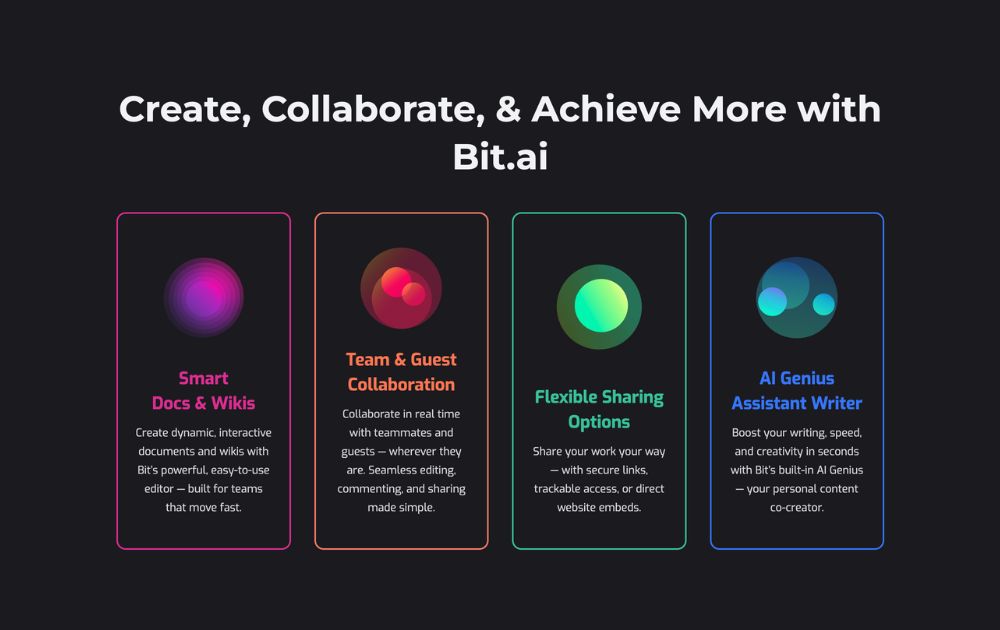
Co-founded by Raj and Saje Sandhu, Bit.ai has been offering document collaboration to companies like Canon and Harvard University since 2007. The company employs a global team with headquarters in San Francisco.
What does Bit.ai offer?
Bit.ai has grown into a smart documentation and knowledge management platform tailored to businesses of all sizes.

With the release of Bit 3.0 and the built-in AI Genius Writer in time for other tech players’ version of AI boom, the tool is now as much about content intelligence as it is about collaboration.
Features include:
- Collaborative document editor with AI assistance
- Smart content library with internal linking
- 100+ file type support and embed options
- AI-powered writing and content structuring
- Automated themes, templates, and formatting
- Cloud integrations (Google Drive, OneDrive, Box, etc.)
- Document tracking and engagement insights
- Branded, interactive documents
- Customizable workspaces and guest access
- SSO, 2FA, and admin-level security controls
We’ll explore some of the key features in the next section.
How much does Bit.ai cost?

Individual users and Bit.ai offers a flexible pricing model suited for individuals, teams, and growing businesses. Here’s a breakdown of the current subscription plans (based on annual billing):
- Free Plan – $0/user/month. Includes up to 10 documents per user, 5-user limit, single document import, access to integrations and collaborative workspaces. Exporting, version history, and AI tools are not included.
- Pro Plan – $8/user/month (billed annually). Offers unlimited documents and users, bulk document import/export, access to version history, and 20,000 AI Genius Writer words (with add-on). Also includes advanced permissions and external sharing features.
- Business Plan – $15/user/month (billed annually). Includes everything in Pro plus more advanced collaboration features like guest access, embed options, and extended AI capabilities. Also includes top-tier permissions and document management features.
Monthly billing is available at higher rates. Bit.ai also provides custom enterprise plans and continues to offer discounted rates for education, startups, and nonprofits.
Bit.ai Review: How to sign up
Getting started with Bit.ai is as simple as inputting your email and receiving a six-digit verification code.
After that, you’re asked to fill out information like your name, your job title, and your department at your company, as well as create a password. Right off the bat, Bit puts businesses first, setting itself apart from Google Docs before you even log in.
But it doesn’t stop there. When you sign up, you create a profile for your whole company, getting a custom subdomain for your team to access your library.
And there you have it! Once you’re logged in, you have the option to see a tutorial. If you want to upgrade to a paid plan, use the handy “Upgrade” button in the lower left corner of your dashboard.
Bit.ai Review: Features
The Bit.ai web app includes tabs for your dashboard and a list of all your workspaces.
The Bit.ai dashboard

Your Bit.ai homepage allows you to view recent activity, featured templates, tutorials and updates, as well as see how close you are to your document limit if you’re a free user.
Free users get access to most core collaboration features but not premium functions like AI, exporting, or advanced version tracking.
You can open documents directly from the dashboard, but only using a featured template or a recently-opened one. To create something from scratch, you’ll have to head over to Workspaces.
The Workspaces tab

First thing’s first: create a workspace. Workspaces are where your documents are created, saved, and shared. Once you’ve made one, you can create a new document, either by using a template, importing an existing document, or starting from scratch.
Creating a document with Bit.ai

When you create a new document in Bit.ai, you’re taken to a bare-bones writing editor similar to Notion. In addition, AI Genius Writer is now integrated into the editor to assist with outlines, rewriting, or prompts. I always find it hard to start writing when you don’t have anything visual to guide you, but once you get the hang of it, it’s fairly intuitive.
I think the reason for this no-frills approach is to make it easier to take meeting notes and write down quick thoughts about a project. For more in-depth functions, however, you can highlight your text after you’ve written it to change the formatting. There’s also a + icon next to your cursor that lets you add links, embeds, files, code blocks, and more.
One neat feature of this text editor is the ability to link directly to other documents and content in your Bit.ai library. It makes it much easier to cross-reference documents than it is in Google Docs, Word, Notes, etc., another great benefit for businesses.

There’s no need to save your documents in Bit.ai—that happens automatically. When you’re done, however, you can share it with collaborators and others, lock it to prevent further edits, change its associated colors, view stats and version history. Note: exporting, version history, and AI writing are reserved for Pro and Business plans.
Bit.ai writing templates

Bit offers a huge range of templates, with themes geared towards managers, marketers, designers, educators, and much more. Some of these are designed to function as static documents, such as thesis papers. Others can be hubs for entire business processes, like the video production template.
After trying out a few of these templates, they’re great at showing off all of Bit.ai’s functionality, but they’re useful even if you don’t use Bit for everything. They offer great templates for outlining your processes, making it easier to set a roadmap and including things you might not have thought of.
Importing documents into Bit.ai
While Bit.ai professes to support a massive range of file types, their import menu is a little peculiar. You can choose to import from “Word” (which just allows you to import .docx files from your computer), from a number of cloud-based sources, or Markdown, .txt, and .pdf files.
The strange thing is, you can’t click on “Word” and then upload a .txt file, nor can you click on “PDF” and upload a Word doc. I have no idea why it’s formatted like this, but it made my upload attempts very confusing.
Not to mention, formatting isn’t included when you upload, and the first two uncommon file types I tried (Pages and Final Draft) were both incompatible.
As of 2025, Bit.ai also includes AI Genius Writer in its paid plans—an AI assistant built into the editor that helps generate content, rewrite sections, and build outlines based on your input.”
Bit.ai Review: Final thoughts
So, how does Bit.ai live up to its thesis statement? Is it really “the world’s most powerful document collaboration platform”?
It may not be the most powerful, but it’s certainly grown into one of the smartest options for teams and businesses. While it’s still not a traditional writing tool—you won’t get full font customization or a rich formatting toolbar—it now offers much more under the hood.
With features like AI Genius Writer, smart internal linking, advanced templates, and built-in document analytics, Bit.ai shines as a modern content hub for collaboration, documentation, and knowledge management.
The platform still has room to improve when it comes to document organization and formatting flexibility, but it’s made impressive strides since its earlier versions.
Final grade: 8/10
Business
Top 10 Best Places to Buy a Mid Century Modern Office Chair
Published
3 weeks agoon
July 4, 2025
What was once old is new again: mid century modern is back in style. From architecture to furniture, the postwar look is in, and the hype extends all the way to office chairs.
Do you need a mid century modern office chair in your life? If so, there’s plenty to choose from. Your office chair should be tailored to your style, whether you like luxury, utility, or something in between.
That’s why we’ve put together our 10 favorite places to find your ideal mid century modern office chair.
What is mid century modern design?
After World War II, spirits were high in the US, and new technology was taking the country by storm. Mid century modern refers to the design concepts that came about during this time.
As opposed to the frilly, ornate designs of classical furnishings, mid century modern designs are angular, material, and functional. Wood is a common design element, especially teak. Mid century modern furniture may also have materials like glass, vinyl, and metal. Designs are simple and geometric, with bold accent colors to make them pop.
The mid century modern aesthetic never really went away, but it’s made a noted comeback in recent years. Some have chalked it up to Boomer and Gen X nostalgia, others point to mid-century-set shows like Mad Men and The Marvelous Mrs. Maisel.
Why should I buy a mid century modern office chair?
Mid century modern is the perfect fusion of style and utility. If you want to cultivate an office space that commands respect without being ostentatious, mid century modern is the style for you.
When it comes to office chairs, an MCM one is often made with sturdy wood and vinyl. They combine the ergonomics of a modern office chair with old-fashioned grace.
If you’re concerned with utility and utility only, a more bog-standard office chair may suit you. But a mid century modern office chair is great for someone who wants to wow colleagues with a mature, thoughtful business space.
Where can I get a mid century modern office chair?
1) Wayfair
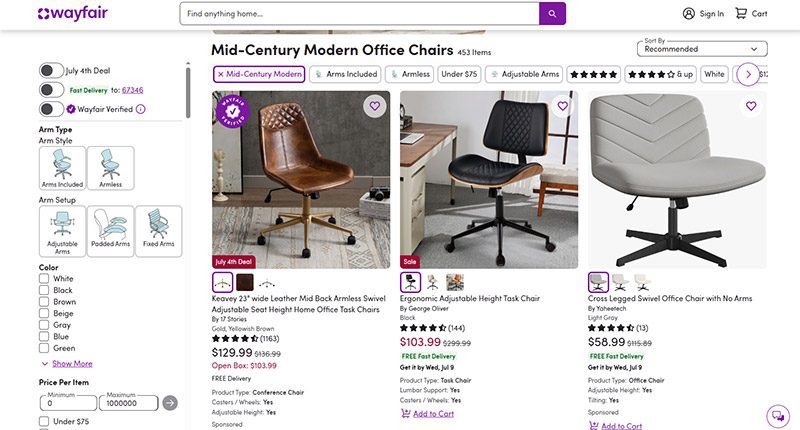
When it comes to furniture, Wayfair offers the best of both worlds. Their goods, including their mid century modern office chairs, are stylish and affordable. You can get a sturdy task chair for less than $100 or a more distinguished seat for less than $350.
MCM office chair examples: Dovray ($126), Bradford ($139), Lithonia ($133)
2) France & Son

Wayfair’s chairs are affordable, but France & Son is the perfect option for luxury shoppers. Their mid century modern office chairs are robust and sleekly designed. If you dress to impress and enjoy the finer things in life, these are the chairs for you.
MCM office chair example: Brooks ($695)
3) Houzz

Started as a community for people to share home decor tips, Houzz has become a great ecommerce platform for finding stylish furniture. They’re more known for home decor than desk chairs, but they have plenty of great, affordable finds if you know where to look.
MCM office chair examples: Arvilla ($173), Rathburn ($259)
4) Laura Davidson
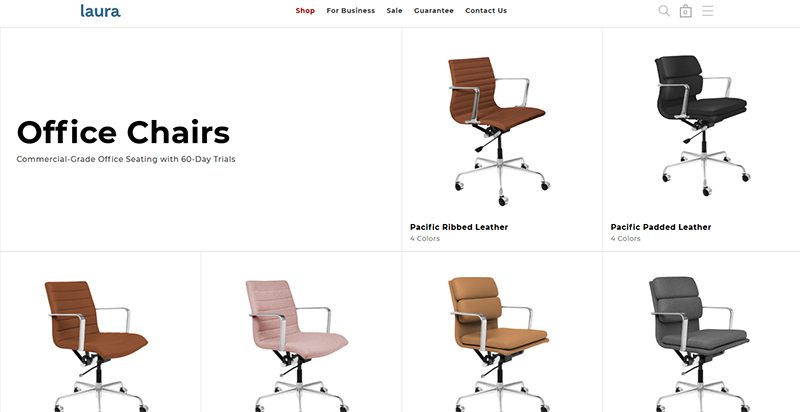
The Laura Davidson collection offers a fairly limited selection of classic office furniture. Still, there’s a reason they’re trusted by big-wigs like Apple, Disney, and Salesforce. Their chairs are sturdy and beautifully designed, reimagining classic Eames and Knoll designs.
MCM office chair examples: Rockefeller ($275), SOHO II Soft Pad ($450)
5) Icons of Manhattan

Icons of Manhattan has a simple philosophy: do one thing, and do it right. Their office chairs are handcrafted from premium materials and tailored to a mid-century modern style. If you want that Mad Men energy in your office (hopefully with a lot less angst), these are the chairs for you.
MCM office chair example: Ribbed Medium ($219)
6) Amazon

Yes, the internet’s premier shopping destination has a robust collection of mid century modern office chairs. Like with most products, their selection of seats is vast and can be hit or miss. Still, they’ve got stunning chairs available for any style, whether you care about comfort, class, or ergonomics.
MCM office chair examples: IDS Home Modern ($219), Art Leon MCM Swivel ($139)
7) AllModern

AllModern’s collection of desk chairs and other furniture truly embodies the mid century modern spirit. Their work is tight, angular, and functional above all. They’re part of the Wayfair family and they traffic in a number of modern styles, but their sleek chairs are perfect for any mid century modern space.
MCM office chair examples: Frederick ($229), Kealey ($349)
8) Overstock
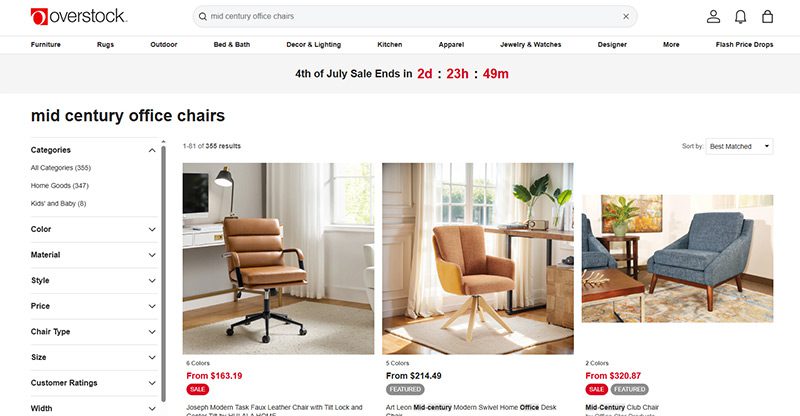
Overstock is known as a one-stop shop for quality home goods at sub-wholesale prices. If you want a spiffy mid century modern office chair that won’t break the bank, they’re the first place to look. While they’re somewhat less reliable than the more upscale platforms on this list, their selection is massive.
MCM office chair example: Joseph Modern ($163)
9) Walmart

Hayneedle’s selection of mid-century modern office chairs falls somewhere between the minimal Laura Davidson and the endless Amazon catalog. Their array of mid-century designs is affordable and versatile, with chairs that match almost any style. While they may be part of the Walmart family, these chairs are anything but second-rate.
MCM office chair example: Waleaf ($97)
10) Target
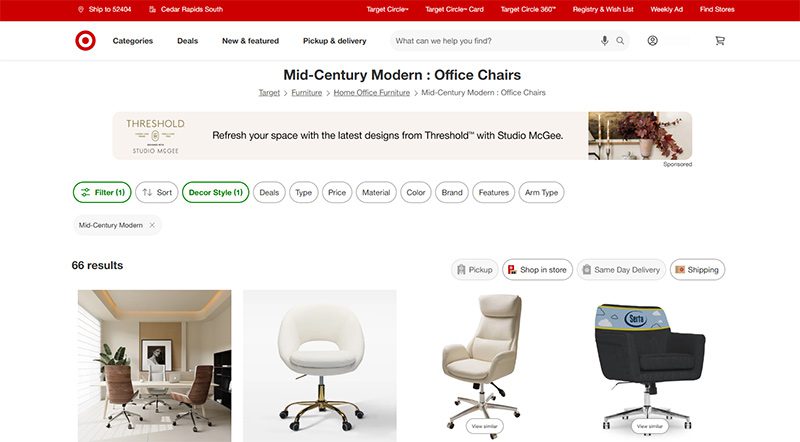
Why splurge when you can save? As usual, Target is a hidden gem, offering a sturdy selection of mid century modern office chairs for some of the cheapest prices out there. Many of the chairs they offer are from the same designers as these other stores—Christopher Knight, LumiSource, Armen Living, etc.—at reduced prices.
MCM office chair example: Lombardi ($136)

Scientists May Soon Predict Earthquakes with 80% Accuracy Two Days in Advance

Adam Neumann: Crashed WeWork, Got $350M from Silicon Valley

The Best Telescopes of 2025 for the BEST Viewing Experience

Bit.ai Review for Businesses in 2025: Is It Still Worth It?

Should I Buy an Electric Scooter? What You Can Learn

Best Workflow Mapping Tools for Smarter Business Processes

Top White Label Marketing Tools for Agencies: Our 10 Best Picks

Top White Label Marketing Tools for Agencies: Our 10 Best Picks

Bit.ai Review for Businesses in 2025: Is It Still Worth It?

The Best Telescopes of 2025 for the BEST Viewing Experience

Virtual Reality Exhibit Carne Y Arena: The Refugees’ Plight

Best Workflow Mapping Tools for Smarter Business Processes

Top 10 Podcast Editing Software Applications for Beginners

Adam Neumann: Crashed WeWork, Got $350M from Silicon Valley
Trending
- Business3 days ago
Bit.ai Review for Businesses in 2025: Is It Still Worth It?
- Technology1 day ago
The Best Telescopes of 2025 for the BEST Viewing Experience
- Business1 day ago
Adam Neumann: Crashed WeWork, Got $350M from Silicon Valley
- Top Stories14 hours ago
Scientists May Soon Predict Earthquakes with 80% Accuracy Two Days in Advance



